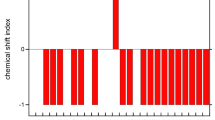Abstract
It is known that melittin in an aqueous solution undergoes a conformational transition between the monomer and tetramer by variation in temperature. The transition correlates closely with isomers of the proline residue; monomeric melittin including a trans proline peptide bond (trans-monomer) is involved directly in the transition, whereas monomeric melittin having a cis proline peptide bond (cis-monomer) is virtually not. The transition has been explored by using nuclear magnetic resonance spectroscopy in order to clarify the stability of the tetrameric conformation and the cooperativity of the transition. In the light of temperature dependence of chemical shifts of resonances from the isomeric monomers, we qualitatively estimate the temperature-, salt-, and concentration-dependence of the relative equilibrium populations of the trans-monomer and tetramer, and show that the tetramer has a maximum conformational stability at 30–45 °C and that the transition cooperativity is very low.






Similar content being viewed by others
References
Bello J, Bello HR, Granados E (1982) Conformation and aggregation of melittin: dependence on pH and concentration. Biochemistry 21:461–465
Brown LR, Lauterwein J, Wüthrich K (1980) High-resolution 1H-NMR studies of self-aggregation in aqueous solution. Biochim Biophys Acta 622:231–244
Dempsey CE (1990) The actions of melittin on membranes. Biochim Biophys Acta 1031:143–161
Dias CL, Ala-Nissila T, Wong-ekkabut J, Vattulainen I, Grant M, Karttunen M (2010) The hydrophobic effect and its role in cold denaturation. Cryobiology 60:91–99
Finkelstein AV, Ptitsyn OB (2002) Protein physics: a course of lectures. Academic Press, Amsterdam
Goto Y, Hagihara Y (1992) Mechanism of the conformational transition of melittin. Biochemistry 31:732–738
Graziano G (2010) On the molecular origin of cold denaturation of globular proteins. Phys Chem Chem Phys 12:14245–14252
Hagihara Y, Kataoka M, Aimoto S, Goto Y (1992) Charge repulsion in the conformational stability of melittin. Biochemistry 31:11908–11914
Hagihara Y, Oobatake M, Goto Y (1994) Thermal unfolding of tetrameric melittin: comparison with the molten globule state of cytochrome c. Protein Sci 3:1418–1429
Iwadate M, Asakura T, Williamson MP (1998) The structure of the melittin tetramer at different temperatures: an NOE-based calculation with chemical shift refinement. Eur J Biochem 257:479–487
Kaya H, Uzunoğlu Z, Chan HS (2013) Spatial ranges of driving forces are a key determinant of protein folding cooperativity and rate diversity. Phys Rev E 88:044701(1)–044701(5)
Kemple MD, Buckley P, Yuan P, Prendergast FG (1997) Main chain and side chain dynamics of peptides in liquid solution from 13C NMR: melittin as a model peptide. Biochemistry 36:1678–1688
Kleckner IR, Foster MP (2011) An introduction to NMR-based approaches for measuring protein dynamics. Biochim Biophys Acta 1814:942–968
Lauterwein J, Brown LR, Wüthrich K (1980) High-resolution 1H-NMR studies of monomeric melittin in aqueous solution. Biochim Biophys Acta 622:219–230
Levitt MH (2001) Spin dynamics: basics of nuclear magnetic resonance. Wiley, Chichester
Makhatadze GI, Privalov PL (1995) Energetic of protein structure. Adv Prot Chem 47:307–425
Miura Y (2012) NMR studies on the monomer–tetramer transition of melittin in an aqueous solution at high and low temperatures. Eur Biophys J 41:629–636
Murphy KP, Freire E (1993) Structural energetics of protein stability and folding cooperativity. Pure Appl Chem 65:1939–1946
Murphy KP, Privalov PL, Gill SJ (1990) Common features of protein unfolding and dissolution of hydrophobic compounds. Science 247:559–561
Othon CM, Kwon O, Lin MM, Zewail AH (2009) Solvation in protein (un)folding of melittin tetramer monomer transition. Proc Natl Acad Sci USA 106:12593–12598
Plaxco KW, Simons KT, Ruczinski I, Baker D (2000) Topology, stability, sequence, and length: defining the determinants of two-state protein folding kinetics. Biochemistry 39:11177–11183
Privalov PL (1990) Cold denaturation of proteins. Crit Rev Biochem Mol Biol 25:281–305
Ptitsyn OB (1995) Molten globule and protein folding. Adv Prot Chem 47:83–229
Qiu W, Zhang L, Kao Y, Lu W, Li T, Kim J, Sollenberger GM, Wang L, Zhong D (2005) Ultrafast hydration dynamics in melittin folding and aggregation: helix formation and tetramer self-assembly. J Phys Chem B 109:16901–16910
Raghuraman H, Chattopadhyay A (2006) Effect of ionic strength on folding and aggregation of the hemolytic peptide melittin in solution. Biopolymers 83:111–121
Ramalingam K, Bello J, Aimoto S (1991) Conformational change in melittin upon complexation with an anionic melittin analog. FEBS Lett 295:200–202
Ramalingam K, Aimoto S, Bello J (1992) Conformation studies of anionic melittin analogues: effect of peptide concentration, pH, ionic strength, and temperature—models for protein folding and halophilic proteins. Biopolymers 32:981–992
Wilcox W, Eisenberg D (1992) Thermodynamics of melittin tetramerization determined by circular dichroism and implications for protein folding. Protein Sci 1:641–653
Wüthrich K (1986) NMR of proteins and nucleic acids. Wiley, New York
Author information
Authors and Affiliations
Corresponding author
Rights and permissions
About this article
Cite this article
Miura, Y. NMR chemical shift analysis of the conformational transition between the monomer and tetramer of melittin in an aqueous solution. Eur Biophys J 45, 347–354 (2016). https://doi.org/10.1007/s00249-015-1102-1
Received:
Accepted:
Published:
Issue Date:
DOI: https://doi.org/10.1007/s00249-015-1102-1




